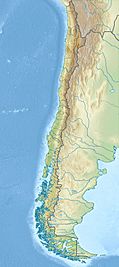Tapado Glacier facts for kids
Quick facts for kids Tapado |
|
|---|---|
| Coordinates | 30°08′S 69°55′W / 30.133°S 69.917°W |
| Area | 3.6 km2 (0 sq mi) |
The Tapado Glacier is a large, slow-moving river of ice located in the country of Chile. It is an important part of the natural landscape in the Andes Mountains. This glacier helps us understand more about Earth's climate and water resources.
Contents
What is a Glacier?
A glacier is a huge body of ice that forms over many years. It starts when snow falls and does not melt completely in the summer. Over time, new layers of snow pile up. The weight of the new snow presses down on the old snow. This pressure turns the snow into dense ice. Glaciers move very slowly, like a frozen river. They flow downhill due to gravity.
How Glaciers Form
Glaciers need two main things to form:
- Plenty of snowfall.
- Cold temperatures all year round.
This allows snow to build up faster than it melts. As more snow accumulates, it compacts. This process creates the thick, solid ice of a glacier.
Types of Glaciers
There are different types of glaciers. Some are found in valleys, like the Tapado Glacier. Others cover large areas of land, like ice sheets. Glaciers are found on every continent except Australia. They are very common in high mountains and polar regions.
Where is Tapado Glacier Located?
The Tapado Glacier is found in the high mountains of Chile. Specifically, it is located in the Coquimbo Region of Chile. This area is part of the mighty Andes Mountains. The Andes stretch along the western side of South America. They are home to many glaciers.
Geographic Features of the Area
The region around Tapado Glacier is rugged. It has tall peaks and deep valleys. The glacier sits at a high elevation. This means it is very cold there. The cold temperatures help the glacier survive. The glacier's exact coordinates are 30°08′S 69°55′W.
Why is Tapado Glacier Important?
Glaciers like Tapado are vital for several reasons. They are natural storage places for fresh water. When the ice melts, it provides water for rivers and streams. This water is used by people and animals. It helps with farming and drinking water.
Water Source
In many dry regions, meltwater from glaciers is a key water source. It can be especially important during dry seasons. The Tapado Glacier contributes to the water supply in its region. This makes it valuable for local communities.
Climate Indicator
Glaciers are also important indicators of climate change. When the Earth's temperature rises, glaciers tend to shrink. Scientists study glaciers to understand how our planet's climate is changing. The size and movement of glaciers give clues about global warming.
How Glaciers Change
Glaciers are always changing. They grow when more snow falls than melts. They shrink when more ice melts than snow falls. This balance is called the glacier's mass balance.
Glacier Retreat
Many glaciers around the world are getting smaller. This is called glacier retreat. It happens because of rising global temperatures. When glaciers retreat, it can affect water supplies. It can also impact local ecosystems. Scientists monitor glaciers like Tapado closely. They want to understand these changes.
See also
- List of glaciers of Chile
 In Spanish: Glaciar Tapado para niños
In Spanish: Glaciar Tapado para niños


